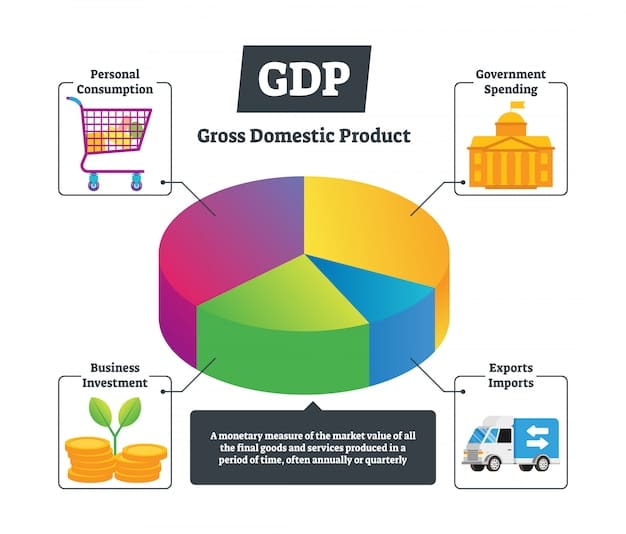Investing for Beginners: How to Start with Just $100 in 2025

Investing with just $100 in 2025 is entirely possible through strategies like fractional shares, ETFs, and robo-advisors, offering beginners accessible entry points into the market with diversified portfolios and professional management.
Thinking about diving into the world of investing but only have a little bit of cash to spare? Don’t worry! This guide will show you how to start investing with just $100: A Beginner’s Guide for 2025, outlining realistic strategies to grow your money, no matter how small the initial investment.
Why Start Investing with $100?
The idea of investing can often feel daunting, especially if you think you require a large sum of money to begin. However, starting small, like with $100, offers various advantages and sets you on the right path for long-term financial success.
Here’s why initiating your investment journey with a limited amount is a clever move:
Learning the Ropes Without High Stakes
Investing involves understanding market dynamics, risk management, and different investment instruments. Starting with $100 allows you to experiment, learn from your mistakes, and grasp the basic concepts without risking significant capital.
Building Momentum and Good Habits
Consistent, even small, investments can create a positive feedback loop. As you witness your initial investments grow (however modestly), it motivates you to save more and invest further. This cultivates the habit of regular saving and investing, which is essential for achieving long-term financial goals.
Accessing Diversification
Thanks to the availability of fractional shares and Exchange Traded Funds (ETFs), even a small amount like $100 can be diversified across multiple companies or asset classes. Diversification reduces the risk associated with investing in a single asset. Instead of putting all your eggs in one basket, you spread your investments across different sectors, industries, and geographies.

Committing to investing, regardless of the amount, can be a powerful step toward financial freedom. Knowing how to invest 100 dollars to start doesn’t have to be intimidating; it’s an achievable goal with the right strategy and mindset.
Understanding Investment Options with Limited Capital
When operating on a tight investment budget, it’s crucial to understand which investment options work well for small sums like $100. Focusing on accessibility, diversification, and potential for growth are paramount.
Here are a few suitable options:
Fractional Shares
Fractional shares allow you to buy a portion of a single share of a company. Traditionally, you would need to purchase a whole share, which could be expensive for companies like Amazon or Google. With fractional shares, you can invest in these companies with as little as $5 or $10, allowing you to own a piece of high-value stocks.
Exchange Traded Funds (ETFs)
ETFs are investment funds that hold a basket of stocks, bonds, or other assets. They offer instant diversification, spreading your investment across multiple companies or sectors. ETFs can focus on specific industries, market segments, or investment strategies. With $100, you can buy shares in one or more ETFs.
Robo-Advisors
Robo-advisors are automated investment platforms that provide personalized investment advice based on your risk tolerance, financial goals, and time horizon. These platforms build and manage your portfolio using algorithms. Several robo-advisors have no minimum investment requirements or very low minimums, making them accessible for small investors.
- Benefits of Fractional Shares: Access to expensive stocks, ability to diversify with small amounts, ideal for long-term investing.
- Why Choose ETFs: Instant diversification, lower risk compared to individual stocks, various options available based on investment strategy.
- Advantage of Robo-Advisors: Personalized advice, automated portfolio management, low entry barriers for beginners.
When commencing with $100, these investment options give you access to diverse markets, limit your risks, and teach you the fundamentals of investing. Keep your objectives, risk tolerance, and financial condition in mind as you choose the right route.
How to Choose the Right Brokerage Account
Selecting the appropriate brokerage account is a vital step when starting your investment journey. The brokerage firm you select will be your gateway to accessing diverse investment options, and understanding their features and fees can significantly impact your investment returns. Here’s how to pick the right one:
Consider these factors when deciding on a brokerage account:
Fee Structure
Many brokers now offer commission-free trading for stocks and ETFs, which is excellent for beginners. However, look out for other fees such as account maintenance fees, transfer fees, or inactivity fees. Read the fine print to understand all potential costs.
Minimum Investment Requirements
Some brokers have low or no minimum investment requirements, which is ideal when you’re starting with just $100. Others may require a higher minimum to open an account or access certain investment options.
Investment Options
Ensure the brokerage provides access to the types of investments you’re interested in, such as fractional shares, ETFs, or specific stocks. Also, check whether they offer educational resources and tools that can help you make informed investment decisions.

User Experience
The platform should be easy to navigate, especially on mobile devices. A user-friendly interface can help you track your investments, analyze performance, and make trades more efficiently.
Choosing the right brokerage firm is instrumental when starting to invest; consider your options wisely. Weigh these variables against your specific goals to identify the firm that best supports your investment journey.
Creating a Diversified Portfolio with $100
Diversification is a cornerstone of sound investment strategy, even when you’re working with a small budget. By spreading your investments across different asset classes, sectors, and geographies, you can reduce your overall risk and increase your chances of achieving long-term growth.
Here are some tips on how to diversify your portfolio with just $100:
Invest in a Broad Market ETF
One of the simplest ways to diversify is to invest in an ETF that tracks a broad market index, such as the S&P 500. These ETFs hold stocks from a wide range of companies, industries, and sectors, giving you instant exposure to the overall market. With $100, you can purchase a few shares of an S&P 500 ETF and diversify your investments.
Consider Sector-Specific ETFs
You might also opt to invest in ETFs that focus on particular sectors of the economy, such as technology, healthcare, or consumer goods. By spreading your investment across various sectors, you can reduce the impact of any single sector’s performance on your portfolio.
Take Advantage of Fractional Shares
Fractional shares let you buy pieces of diverse stocks, making a focused portfolio even on a limited budget. Choose a few stocks from distinct sectors to expand your investments.
- Utilize ETFs: ETFs with broad exposures help diversify risk and benefit from market growth.
- Sector-specific investments: Select ETFs from distinct sectors to boost balance and manage risk exposure better.
- Integrate fractional shares: Add select stocks using fractional share options to refine diversification strategies.
Diversifying your portfolio doesn’t require a huge capital; even with $100, one can build a balanced portfolio by understanding the market and resources available. Careful planning can set you on the path of secure, long-term investment success.
Tracking Your Investments and Rebalancing Your Portfolio
Once you’ve started investing, it’s essential to track your investments and rebalance your portfolio regularly. By monitoring your portfolio’s performance and making adjustments as needed, you can ensure that you stay on track toward your financial goals.
Here are some strategies for tracking and rebalancing:
Monitor Your Portfolio Regularly
Keep track of the performance of your investments, checking their performance both daily and monthly to recognize trends. This allows you to see how your assets are doing and make well-grounded decisions promptly.
Set Performance Benchmarks
Create clear expectations by comparing your portfolio’s returns against appropriate industry standards like the S&P 500. Establishing such criteria helps you evaluate if your performance aligns with initial expectations.
Rebalance Periodically
Rebalancing ensures your portfolio remains aligned with your target asset allocation. If certain assets have outperformed others, your portfolio may become overweighted in those areas. Rebalancing involves selling some of the overweighted assets and buying more of the underweighted ones.
Keeping regular tabs on performance, setting clear benchmarks, and rebalancing are critical. Staying proactive and knowledgeable ensures one’s investment strategy is successful and aligned with financial objectives.
Common Mistakes to Avoid When Starting with $100
Beginning with $100 may appear easy, but there are common mistakes that new investors should avoid to protect their investment and promote sustainable growth.
Here’s what to look out for:
Not Doing Enough Research
Jumping into unstudied investments can result in significant losses. Completely understand where your money is going by researching, reading and understanding reports, and staying aware of market updates.
Emotional Decision-Making
Reacting too strongly to short-term market changes can lead to poor selling or buying decisions. Create strategies based on rational thinking and long-term goals–avoid sudden emotional changes.
Ignoring Fees
All investment platforms entail fees. Undetected, these can eat into profits, especially when quantities are smaller. Gain awareness of all fees including trading costs, account upkeep, and transaction fees, to manage and optimize your expenses.
- Prevent under-researching: Dedicate time to scrutinize investments, examining markets and thoroughly reviewing information.
- Avoid emotional trades: Make considered decisions using researched plans, as emotions can result in rash judgments.
- Fee monitoring: Recognize how fees impact gains, so that your cost-benefit strategy remains beneficial.
Avoiding familiar mistakes can greatly enhance your chances of financial success, even when commencing with $100. Being informed, rational, and attentive is vital when navigating the financial waters.
| Main Point | Brief Description |
|---|---|
| 💡 Start Small | Begin investing with $100 to learn without high risk. |
| 🌱 Diversify | Use ETFs and fractional shares for a balanced portfolio. |
| 💰 Avoid Fees | Watch out for trading and account fees that reduce returns. |
| 📊 Track Progress | Regularly monitor investments and rebalance as needed. |
Frequently Asked Questions
▼
Yes, with fractional shares and low-minimum ETFs, $100 is sufficient to start! Platforms like robo-advisors also offer diversified portfolios without high initial investment requirements.
▼
Fractional shares let you buy a portion of a single share of a company. This enables investing in high-value stocks with a small amount, diversifying your portfolio even with limited funds.
▼
An ETF (Exchange Traded Fund) is a fund that holds a basket of stocks or other assets. It provides instant diversification and is a low-cost way to invest in a specific market segment or industry.
▼
Rebalance your portfolio at least annually, or more frequently if you notice significant deviations from your target asset allocation. Regular rebalancing helps maintain your desired risk level.
▼
Losing some initial investment is part of learning. View it as a lesson and adjust your strategy next time. Always diversify and avoid high-risk investments when starting out.
Conclusion
Starting to invest with just $100 is not only feasible but also a smart way to learn, build good financial habits, and work toward long-term financial success; with strategies like fractional shares, ETFs, and robo-advisors, anyone can take their first steps into the world of investing and lay the groundwork for a prosperous financial future.





